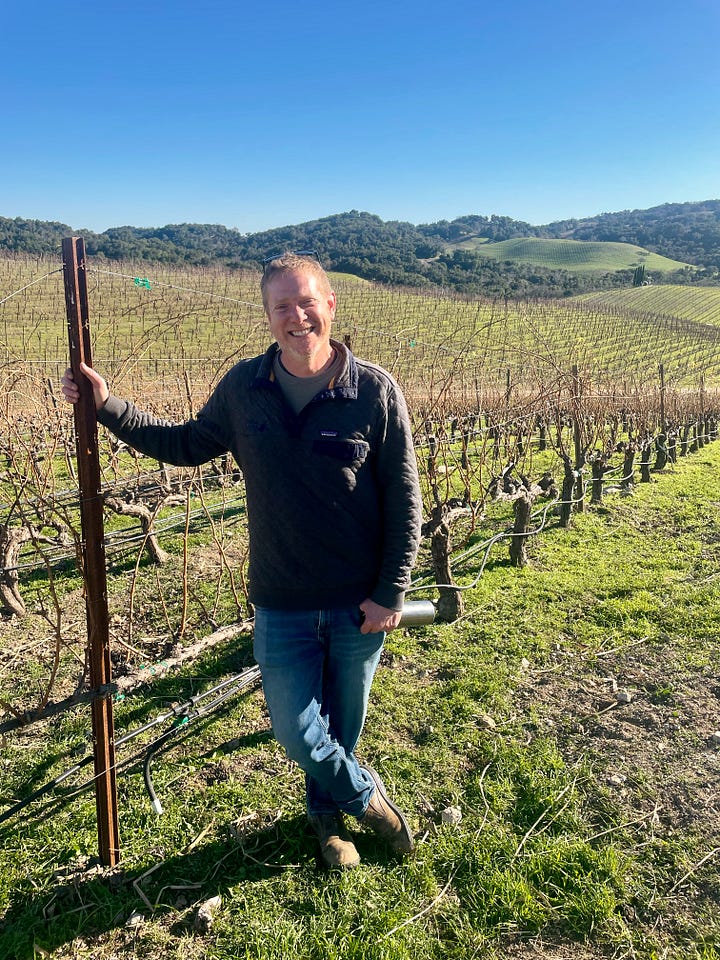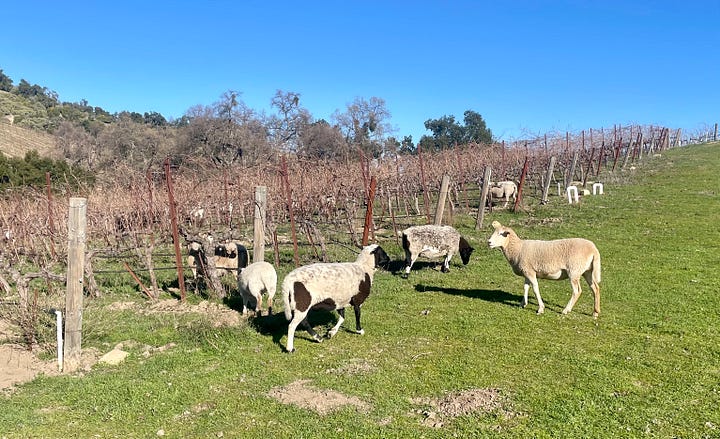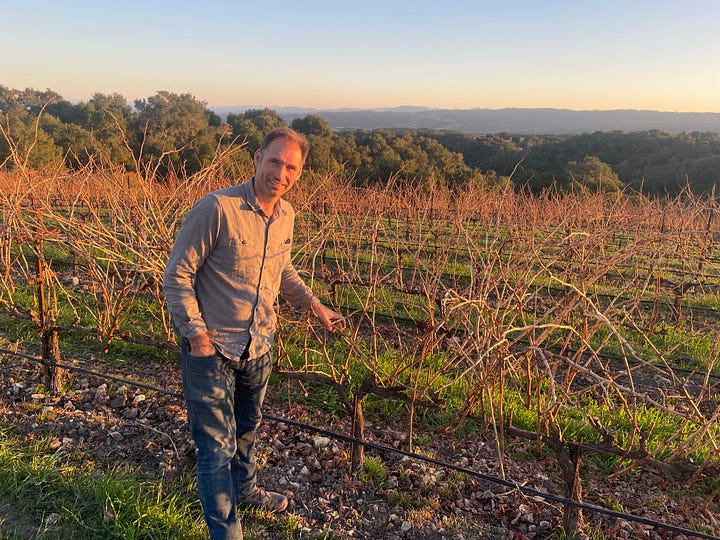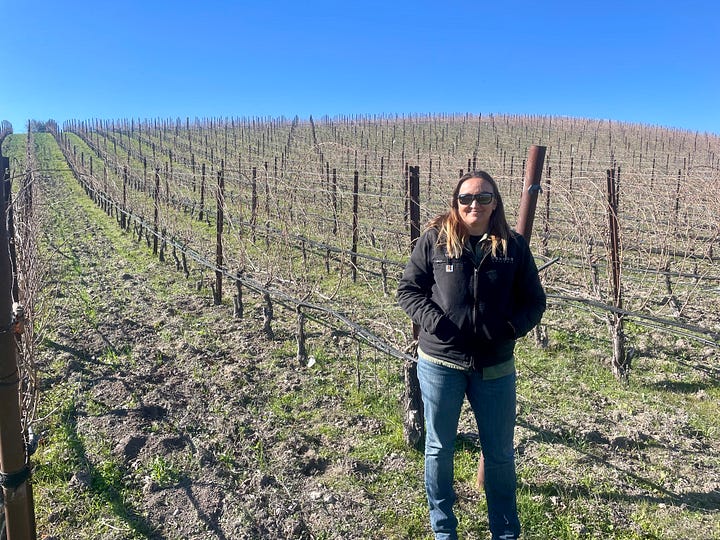On the trail of California's Rhône rangers
Around the Central Coast town of Paso Robles, Grenache and Syrah are kings, making Rhône-style wines of a quality to challenge Napa and Sonoma. Plus: what (else) I've been drinking this week




I was on a mission to drink Rhône-style wines, rich Grenache- and Syrah-dominated blends. I drove up and down steep hills along sleepy, tree-lined roads dappled with winter sunshine, bright blue sky above: I could almost have been in Vacqueyras. Any such illusion was dispelled as I approached the slick tasting room at Epoch Wines, Neil Young’s Heart of Gold playing in the background to lend the scene a country vibe. For this was not France but Paso Robles, in the middle of California.
Twenty five years ago, Paso Robles was a fading rural backwater. There were a few vineyards but local farming was still mostly ranching. Where there were vines, Zinfandel was the grape of choice, producing powerful reds: nothing to challenge the Californian wine elite up in Sonoma and Napa, 250 miles to the north.
But an experiment was already under way at Tablas Creek, which had produced its first Rhône-style vintage in 1997. Tablas was the brainchild of New York wine importer Robert Haas and leading Châteauneuf-du-Pape producers, the Perrin family of Château de Beaucastel.
Haas’s father owned a successful wine shop in New York, and on joining the firm in 1950, Robert started importing wines. By the 1960s, he was the exclusive US importer of Bordeaux superstars Château Lafite and Pétrus – and later of Rhône wines too. Thus Haas struck up a friendship with Jacques Perrin, later bringing his sons Jean-Pierre and François over to California to try wines from the first wave of Sonoma and Napa stars that he represented, such as Kistler and Joseph Phelps. The Perrins were impressed – but wondered why nobody was planting Rhône grapes in California’s Mediterranean climate. And then, in the 1970s, Haas and the Perrins started talking about a dream of creating a Californian Châteauneuf-du-Pape.
Gradually the idea took shape, and after four years looking for right spot, they bought the land in 1989. Robert’s son Jason, who now runs the business, explains: “this was only place they found calcareous shale at the surface – like in Châteauneuf.” Those rocks are found on one side of the fault line locally where the North American and Pacific tectonic plates collide: the calcareous rocks and soils are on the west side, over the Pacific plate. The rock is porous and soft, acting as a sponge to soak up rainfall in winter that vines can access during the hot summer months.
The Rhône terroir similarities don’t end there. As well as calcium-rich soils, the area has the biggest diurnal temperature range in California, the gap between the highest and lowest temperatures in a 24-hour period: after a 40℃ summer day, the mercury drops to 15℃ at night. This causes the vines to shut down overnight and thereby stop losing acids. Oliver Esparham, General Manager of Law Estate Wines, adds: “When you get that limestone and calcium carbonate content it helps regulate pH.”
And there is a long, sunny growing season: growers pick red grapes here as late as early November. This is especially important for the notoriously late-ripening Mourvèdre grape. “You’d have a hard time getting Mourvèdre ripe in Napa,” says Esparham, “and you’d also lose acidity with hang time.” It’s also dry enough to reduce the threat of vine diseases. “It’s easy to be organic here,” says Hilary Graves, Vineyard Manager at Booker Wines. “There’s very little powdery mildew pressure.”
Nevertheless, when Jason Haas joined his father here in the early 2000s, their commercial progress was still slow. “It was hard at first,” he remembers, “because we were making blends [as opposed to single-varietal bottlings], of grapes people couldn’t pronounce, with French names that didn’t mean anything, in a part of Californian nobody had heard of.”
In fact, winemaker John Alban was already pioneering Rhône varietals here. As he wrote last year, “I spent a lot of time wondering why Europe fermented over 500 different grape varieties, while California was using about six.” The likes of Randall Grahm of Bonny Doon Vineyard, near Santa Cruz, and Bob Lindquist of Qupé (Santa Barbara) were experimenting with Grenache and Syrah in the 1980s, but they were in a small minority. Alban got his Master’s in oenology at the University of California, Davis and in the early 1990s produced the first American Viogniers and Roussannes (when, he says, there were fewer than 50 acres of Viognier planted in the world, most of them in their northern Rhône home.)
“It was hard at first because we were making blends, of grapes people couldn’t pronounce, with French names that didn’t mean anything, in a part of Californian nobody had heard of.”
Then in 1998, a group of like-minded producers formed the Rhône Rangers, a non-profit promoting Rhône varietals; today it has around 100 members. A year later, Alban founded the Hospice du Rhône, a bi-annual gathering of Rhône grape growers, importers, sommeliers and Grenache nerds. It now takes place in Paso Robles every two years, though the last one, in 2024, was in Walla Walla, Washington, another Grenache and Syrah hotspot.
Paso Robles’s reputation got a big boost in 2005 from its first visit by uber-wine critic, Robert Parker. The great Bordeaux guru was excited, declaring that “there is no question that a decade from now, the top viticultural areas of Santa Barbara, Santa Rita Hills, and the limestone hillsides west of Paso Robles will be as well-known as the glamorous vineyards of Napa Valley."
Haas also points to the release of iconic wine road-trip movie Sideways in 2004. While the adventures of wine-nerd Miles and his friend Jack in Sideways were set in Santa Barbara, the film nevertheless drove a big increase in people visiting wine country. Indeed Haas says that such was the buzz around the film that he heard complaints from Angeleno wine lovers that Santa Barbara had become full of movie tourists – persuading them to drive another hour or so north to Paso Robles.
The same year, geologists Bill and Liz Armstrong first bought land here. They planted Rhône varietals from the start, making Epoch Estate Wines’ first vintage in 2007; previously there was some Zinfandel on the property, and indeed the first vineyard in Paso was on this site, its Zinfandel vines planted in 1882. But as Vince McGranahan at Epoch told me last week, “Paso is the Wild West. It gives you freedom about what you use in your wine.”
Since the 2000s, the area has seen rapid growth in wine production. Esparham points to Wine Spectator magazine’s 2010 front-cover choice of Saxum winery’s Justin Smith as both winemaker of the year and creator of the wine of the year (that was also Law Wine’s first vintage.) Later, local producers were helped by the virtual shutdown of Napa in 2017 after major fires. Tourists flocked in, impressed not just by the wines but their relative affordability compared to pricey Napa (though it must be said, none of these are cheap wines.) Law Estate saw its tourist traffic double that year. The same happened again after more fires in Napa in 2020.
Today there are around 400 wineries around Paso Robles. In fact, Cabernet Sauvignon is still the most-planted grape, though plantings of Rhône varietals are growing faster. It has also become a major wine tourism hotspot, with high-end, striking tasting rooms attracting well-heeled wine lovers. At Booker Wines, after bumping around the bare vineyard in an electric truck with Hilary Graves in near-freezing temperatures, we tasted the wines in a striking wood-and-glass tasting room, winter sunshine streaming in and a fire burning.
Yet Paso Robles is still small enough to be a friendly winemaking community. At almost every winery I visited, my hosts would ask, “Where are you going next?” – and then tell me to give their best to someone there.
I finished my stay with a visit to Guillaume Fabre at Close Solène. Fabre came here from Bordeaux 20 years ago in his mid-20s, aiming to work a year in a winery and go home. He never left, staying here with his French wife; now they have three children, all born here. “I really fell in love with the area and what we can do here,” says Fabre. “To build this today” – he gestures towards some of his 19 hectares in the fading sunset – “would be tough in France.”
I got a sense from Fabre of the hard work involved, as we careered up and down steep vineyards in his truck, and as he explained his plans for a new winery, cellar and tourist area, now under construction. He had worked with his family in wine in Bordeaux and Narbonne, in the Langedoc, but says he had to re-learn many things in the new environment. But there’s also the freedom of winemaking in America: “If I was in France I’d be maybe going to jail,” he jokes of his structured, long Fleur de Solène 2021, a heretical blend of Syrah, Grenache and 25 per cent Cabernet Sauvignon.
In general, this area’s wines tend to be more powerful than their Rhône equivalents - though plenty are restrained and elegant. The Tablas wines are all around 13.5 per cent alcohol or less. But even where they’re bigger - such as those from Epoch and Law - they’re balanced, with good acidity. They’ve found favour in the US in part because of Americans’ openness to new things. “People forget how young wine culture is in America,” says Haas. “It’s only really existed since the 1980s, outside of a European-travelled upper class in east coast cities.”
But he is adamant too that the Tablas should stick to their choice of grapes and styles, whichever way fashions may change in future. It’s a philosophy many here would echo. “The worst thing we could do is bounce our style around to follow what we think people want,” he says. “We just make the best wine we can in our style.”
Where to buy California’s Rhône rangers in the UK
Tablas Creek - The Wine Society, Vinum, Hic! and elsewhere
Epoch Estate Wines - Four Corners Wine Co
Booker Wines - Four Corners Wine Co
Law Estate Wines - Four Corners Wine Co
Clos Solène - Four Corners Wine Co, Millessima
What else I’ve been drinking this week
I was in California to do research for my forthcoming book on wine and sustainability, co-authored with Jane Masters MW, to be published this autumn by the Academie du Vin Library. It will be an accessible introduction to this fascinating issue for the world of wine, and indeed the perfect Christmas 2025 gift for the wine lover/tree hugger in your life (I will evidently be banging on about this in future.) So from Paso Robles I headed north to Sonoma and Napa to see biodynamic and regenerative winemaking in action there too. The following were some of my favourites.
Gundlach Bundschu Estate Gewürztraminer 2023, Sonoma Coast - Gewürztraminer isn’t very common in California and in this case was brought over by this venerable winery’s German founders in 1858. Classic Gewürz fragrance and spicy notes, yet vinified completely dry: crisp, mineral, well balanced and quite long - lovely (N/A UK; from around $16 retail in the US.)
Jackson Family Estate La Crema Pinot Noir 2023, Sonoma Coast - this is Jackson’s flagship red, and while it’s made from both estate and bought-in fruit, the 300-odd parcels that go into it are vinified separately and then blended, what head winemaker Craig McAllister calls “small winemaking at scale”. All of it has seen some French oak but the influence is minor: this is fresh, with clean, pure red fruit - well balanced and and appealing (the 2023 isn’t in the UK yet; 2022 available at Simply Good Wine, Albion Wine Shippers, Cellar Door and elsewhere, from £29.75)
Quintessa Red 2021, Rutherford - this beautiful Napa estate makes just one red, blended, with the help of celebrated Bordeaux consultant Michel Rolland, from 180 separately vinified wines taken frsom a couple of dozen different parcels. Spicy, intense and complex with subtle herbal notes and a hint of menthol, yet in no sense overpowered: great finesse and elegance. Very impressive - but Napa royalty don’t come cheap, I’m afraid (Grand Vin, Tannico, from £185, and from Justerini & Brooks and elsewhere in cases of six.)
Transparency declaration: I visited all the vineyards mentioned in this piece as their guest.




